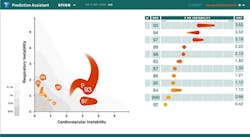How UVA Health created artificial intelligence to watch over patients with COVID-19
At UVA Health, patients with COVID-19 are monitored not just by a phalanx of nurses, physicians and specialists, but also by artificial intelligence software – designed by a University of Virginia physician – that’s continuously computing their physiological data in order to predict whether life-threatening trouble might arise, reported the university health system.
Using numbers drawn every two seconds, and models updated every 15 minutes, the software actually predicts possible clinical issues before they happen, giving clinicians – especially nurses – critical time to head off a potential crisis hours before it strikes.
Since last July, patients with all kinds of serious illnesses convalescing on UVA Health’s fourth floor in the Medical Intensive Care Unit, the Special Pathogens Unit, Cardiovascular Intensive Care Unit, Critical Care Unit, and the Surgical Intensive Care Unit and Intermediary Care Unit have the added benefit of CoMET, new software that uses continuous monitoring and computer algorithms to create a visual portrait of a patient’s risk of experiencing a serious event over the next 12 hours. Moment-to-moment data is drawn from a patient’s EKG, laboratory results and vital signs to create a graphic representing risk on a large LCD screen. That visual helps clinicians gauge patients’ stability and risk for clinical issues, and, if needed, to determine what actions should be taken to protect a patient’s health.
Like a barometer of risk, stable patients’ “comets” are small, yellow and nestle close to the X-Y axis on the display. But if the risk level rises, the comets grow, turn bright orange or deep red, and crawl up and across the screen like plump, shooting stars, indicating cardiovascular instability, respiratory instability or both.
These colorful graphics signal clinicians to employ proactive strategies to stabilize patients’ vital signs before serious medical events, such as sepsis, blood poisoning, respiratory distress or cardiac instability, and the need for ICU-level care happen. For one patient, nursing staff spotted an expanding comet and quickly adjusted oxygen flow, suctioned the patient’s mouth and closely monitored the patient’s status. For another patient, whose growing risk appeared along the cardiovascular axis, nurses alerted physicians to reassess red blood cell levels, ultimately deciding that the patient needed a transfusion.
For COVID patients, said CoMET’s creator, UVA cardiologist Dr. Randall Moorman, the system is especially beneficial, given how quickly and unpredictably their prognoses can change.
“Using precision predictive analytics systems like this one helps nurses initiate clinical response before the scenario becomes, quite literally, life and death,” said Jessica Keim-Malpass, a professor in the School of Nursing and Moorman’s research partner.
Keim-Malpass, who published her research on CoMET’s important aid to nurses on COVID units in the International Journal of Nursing Studies Advances, and UVA cardiologist Jamie Bourque recently began a two-year, randomized controlled study of the software across UVA Health’s entire fourth floor, thanks to a $600,000 bequest. Over the next two years, they’ll randomly assign a CoMET display to half the beds and compare the outcomes of patients in the experimental and control groups to determine the system’s efficacy and impact.
Moorman has long been a pioneer in the field of predictive analytics. Twenty years ago, he and his coworkers discovered that premature babies exhibited abnormal heart rate patterns in the hours before being diagnosed with life-threatening sepsis, and developed a visual risk display similar to CoMET’s called HeRO to alert clinicians to infants whose prognoses were growing worse. In the largest randomized trial of its kind, they found that 3,000 at-risk, low-birth-weight babies across nine hospitals who had a HeRO display at their bedside were 20 percent less likely to die.
Moorman and Keim-Malpass say the new UVA Health study will provide another opportunity to fine-tune the technology in a moment when CoMET holds great promise for health systems seeking to improve their care of COVID patients.
